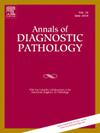Metastatic tumours to the parotid: A 20-year single institutional experience with an emphasis on 14 unusual presentations
IF 1.5
4区 医学
Q3 PATHOLOGY
引用次数: 0
Abstract
The parotid gland is a rare site for distant metastasis. We aim to provide an overview of metastatic tumours to the parotid over the past 20 years, focusing on clinicopathological analysis of 14 rare diagnoses. To the best of our knowledge, we are the first group to present the most up-to-date and largest case series on unusual metastases to the parotid. A total of 93 metastatic cases were identified from 2004 to 2023, on the pathology information system at North West London Pathology, with squamous cell carcinoma (n = 45, 48.4 %) as the most common primary, followed by malignant melanoma (n = 29, 31.2 %) and Merkel cell carcinoma (n = 4, 4.3 %). We came across 14 rare tumours that had metastasised to the parotid, including metastatic adenocarcinoma from kidney (n = 3, 3.2 %), lung (n = 3, 3.2 %) and breast (n = 1, 1.1 %), olfactory neuroblastoma (n = 3, 3.2 %), soft tissue sarcoma (n = 2, 2.2 %), small cell carcinoma (n = 1, 1,1 %) and hidradenocarcinoma (n = 1, 1.1 %). Half of all secondary neoplastic lesions (50.5 %) were found in intra-parotid nodes, while the other half (49.5 %) were found in parotid parenchyma. Our study offers valuable insights into the various tumour types that can metastasise to the parotid across a wide age range. It underscores the necessity of maintaining a broad differential diagnosis. Keeping an open mind regarding the potential primary sources of the tumour is imperative for accurate diagnosis and effective treatment planning.
腮腺转移性肿瘤:20年的单一机构经验,重点关注14种不寻常表现。
腮腺是一个罕见的远处转移部位。我们旨在概述过去 20 年中腮腺转移性肿瘤的情况,重点对 14 例罕见诊断进行临床病理分析。据我们所知,我们是第一个对腮腺异常转移进行最新、最大规模病例系列研究的小组。从2004年到2023年,我们在伦敦西北病理科的病理信息系统上共发现了93例转移病例,其中鳞状细胞癌(45例,占48.4%)是最常见的原发肿瘤,其次是恶性黑色素瘤(29例,占31.2%)和梅克尔细胞癌(4例,占4.3%)。我们发现了 14 例转移到腮腺的罕见肿瘤,包括来自肾脏(3 例,占 3.2%)、肺部(3 例,占 3.2%)和乳腺(1 例,占 1.1 %)、嗅神经母细胞瘤(n = 3,3.2 %)、软组织肉瘤(n = 2,2.2 %)、小细胞癌(n = 1,1.1 %)和隐腺癌(n = 1,1.1 %)。所有继发性肿瘤病变中有一半(50.5%)发生在腮腺内结节,另一半(49.5%)发生在腮腺实质。我们的研究为了解不同年龄段腮腺转移的各种肿瘤类型提供了有价值的见解。它强调了保持广泛鉴别诊断的必要性。对肿瘤的潜在原发来源保持开放的心态是准确诊断和有效治疗计划的必要条件。
本文章由计算机程序翻译,如有差异,请以英文原文为准。
求助全文
约1分钟内获得全文
求助全文
来源期刊
CiteScore
3.90
自引率
5.00%
发文量
149
审稿时长
26 days
期刊介绍:
A peer-reviewed journal devoted to the publication of articles dealing with traditional morphologic studies using standard diagnostic techniques and stressing clinicopathological correlations and scientific observation of relevance to the daily practice of pathology. Special features include pathologic-radiologic correlations and pathologic-cytologic correlations.

 求助内容:
求助内容: 应助结果提醒方式:
应助结果提醒方式:


